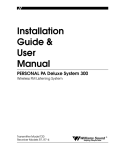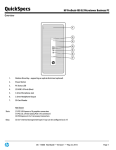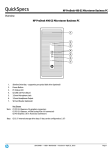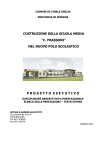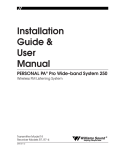Download Williams Sound R700 User manual
Transcript
e es re th su T: N ead d en. r n n TA R es to me aratio i PO nut e t pe IM w mi l sav em o l fe i st a s w sy ng on er ki cti op Ta tru pr s in FM Wireless Listening System Installation and User Manual Transmitter Model T18 Receiver Models R7, R7-4, R7-6, R700 MAN 057 PERSONAL PA BROADCASTING SYSTEM Installation and User Manual Contents: Page Overview 4 Transmitter Controls and Features 4 Transmitter Set-Up and Operation Antenna Connection Power Connection Audio Connection Using a Microphone 5 Receiver Set-Up and Operation 6 Receiver Battery Information 7 Receiver Management Suggestions 8 Using a Remote Antenna 9 Troubleshooting 10 Radio Interference / Tuning Instructions 12 FCC Part 90 Licensing Information 14 Warranty 17 Page 3 Overview The T18 is an FM Listening System Transmitter which operates in the 72 MHz - 76 MHz frequency band. This versatile transmitter is easily integrated with your existing sound system or can be used with a microphone as a stand-alone system. Designed for simultaneous language interpretation and other business applications, the T18 broadcasts to a variety of Williams Sound personal receivers including the R7, R7-4, R7-6, and R700. Federal regulations call for operators of transmitters such as the T18 to be licensed under Part 90 of the FCC Rules and Regulations. Form 600, the appropriate Schedules, and directions for license application are contained in this manual. Transmitter Model T18 Controls and Features: Front Panel: Mic Input: 3.5mm mini phone jack for use with Williams Sound condenser microphones. Supplies +DC power for condenser microphones. Level Control: Screwdriver-adjust control used to set the microphone input level or the audio input level. ON Indicator Light: Glows when power is applied to the transmitter. There is no on/off switch. The T18 is designed to be left on continuously. Williams Sound Auditory Assistance Transmitter Mic Level - Audio On + T18 Front Panel Audio Indicator Light: Flashes when audio signal is present. Rear Panel: Power Input Jack: Connects to the plug on the wall transformer power supply. Audio Input: An RCA-type jack for connecting the transmitter to other sound systems. Accepts line-level, unbalanced audio inputs. Antenna Output Connector: A 75 Ohm, F-type connector for use with the ANT 005 remote antenna. FM Transmitter Model PPA T18 Williams Sound Corp., Minneapolis, MN, USA Antenna Power 12 VAC 100 mA 75 Ohm Audio In Hi-Z Line Made in U.S.A T18 Rear Panel Top Panel: Antenna Mounting Stud: For use with the "rubber duck" type antenna supplied with the T18. Page 4 Transmitter Set-Up and Operation Step 1: Install the antenna. The "rubber duck" whip antenna fits into the hole on top of the transmitter and threads onto a mounting stud inside. Guide the antenna onto the stud and turn it clockwise to tighten. Do not use excessive force to tighten the antenna. It only needs to be finger-tight. See page 9 for instructions on using the remote antenna. Step 2: Connect the transmitter to power. The T18 is supplied with a wall transformer power supply. Plug the transformer into a 120 Volt, 60 Hz wall outlet. Then plug the power cord into the "Power" connector on the rear panel of the T18. The green indicator light on the front panel of the T18 should glow when the power is connected. There is no on/off switch. The T18 is designed to be continuously on. The wall transformer can be plugged into a switched outlet that turns on when the other sound equipment is turned on. If turning the T18 on creates a hum or buzz in the sound system, see the Troubleshooting section on page 10. Step 3: Make audio connections. If you will be using the T18 with an existing sound system Refer to the Overall System Diagram on the next page. Use the audio cable supplied to connect the T18 "Audio In" jack to an appropriate audio output jack on the sound system mixer or amplifier. The T18 is designed to work with an unbalanced, line-level audio signal. Suitable connections are: First Choice: TAPE OUT or LINE OUT Jack Second Choice: BOOSTER or BRIDGING Jack Third Choice: Speaker Terminal, 8 Ohm Tap If your amplifier or mixer does not have RCA-type connectors, you can obtain adapters from your Williams Sound Authorized Dealer or a local radio parts store. If the TAPE OUT jack is already in use, a Y-Cord can be used to connect the T18 and a second device to the same jack. If you will be using the T18 with its own microphone as a stand-alone system Any Williams Sound microphone with a 3.5mm mini phone plug can be used with the T18. Plug the microphone into the "Mic" jack on the front panel of the T18. The T18 supplies positive DC voltage on the plug tip to power condenser microphones. If you use both the Microphone input and the Audio Input on the T18, the signals will be mixed together. Step 4: Use a receiver to test the system and set the input level control. The steps on the following page explain receiver operation. Page 5 Overall System Diagram Microphones Sound System Amplifier Loudspeakers Line-Level Output Line-Level Input FM Pocket Receivers T18 Transmitter w/Earphones Receiver Set-Up & Operation Receiver Models R7, R7-4, R16 Step 1 Install the battery: Open the battery compartment by lifting the tab at the bottom of the receiver. Press the battery into place, observing proper battery polarity. Step 2 Plug the earphone or headphone into the earphone jack. Step 3 Turn the receiver on by rotating the volume control in the direction of the arrow on top of the case. Turning the knob in the direction of the arrow will increase the volume. Turning the knob against the arrow will decrease the volume. To avoid draining the battery, make sure the receiver is turned off when not in use. Step 4 If you are using the T18 with an existing sound system, make sure the sound system is turned on. Have someone speak into a microphone while you listen with the receiver and earphone. You should be able to hear their voice through the receiver. If you are using the T18 with its own microphone, have someone speak into the microphone while you listen with the receiver and earphone. You should be able to hear their voice through the receiver. Step 5 The T18 Transmitter has a screwdriver-adjust input level control located on the front panel to compensate for different input signal levels. The yellow audio indicator light should flash with the signal. If the sound through the receiver is clear and loud and the audio indicator light flashes with the signal, no adjustment is needed. If the sound through the receiver is weak and the audio indicator light does not flash even with the volume control turned all the way up, turn the T18 input level control clockwise to increase the signal. If the sound is loud, distorted, or broken up, and the audio indicator light is continuously on, turn the input level control counterclockwise to decrease the signal. Page 6 Additional Instructions for Receiver Models R7-4 and R7-6 The R7-4 and R7-6 Receivers feature four-channel and six-channel selector knobs, respectively. You’ll find these controls on top of the receiver. Turn the selector knob until you hear the desired program. Instructions for Monitor Receiver Model R700 Step 1 Plug the R700 power cord into a 120 VAC, 60 Hz electrical outlet. Step 2 Attach the antenna to the connector on the rear panel of the R700. Step 3 Turn the power switch on and adjust the volume control until you hear the signal from the transmitter. An optional remote antenna (ANT 005) may be used with the R700 to extend the reception range. An external loudspeaker may be used with the R700. Connect the + (plus) loudspeaker wire to the tip connection of a 1/4" mono phone plug. Connect the - (minus) loudspeaker wire to the sleeve connection of the 1/4" mono phone plug. Insert the plug into the external speaker jack on the rear panel of the R700. This will cut out the built-in speaker and deliver up to 1 Watt of audio power into an 8 Ohm speaker. The R700 speaker output jack may also be connected to the high level input of a PA amplifier. See the instructions included with the R700 for more details. Receiver Battery Information In normal use, a heavy-duty 9 Volt battery such as the Eveready 216 will last about 10 hours. Alkaline batteries such as the Eveready 522 will provide about 17 hours of use. If the sound becomes weak or distorted, replace the battery. The indicator light may still be on, even with a battery that is weak. Do not leave dead batteries in the receivers. Rechargeable Batteries The receivers can also use a rechargeable battery. We recommend only the 7-cell, 8.4 Volt types (BAT 003). (Most batteries available through department and radio stores are 6-cell, 7.2 Volt types. They will not perform satisfactorily with Williams Sound receivers.) A fully-charged battery (Williams BAT 003) will provide about 5 hours of use per charge. The battery may be recharged without removing it from the receiver. The BAT 005 Single Charger has a cord that plugs into the receiver "EAR" jack to charge the battery. The CHG 1269A Multiple Charger can charge 12 receivers simultaneously through the receiver "EAR" jacks. Receivers can be left charging continuously when not in use. The receiver should always be turned OFF while charging. It takes about 14 hours to fully charge the battery. Battery Warnings DO NOT ATTEMPT TO RECHARGE DISPOSABLE BATTERIES! AVOID SHORTING THE PLUS AND MINUS BATTERY TERMINALS TOGETHER WITH METAL OBJECTS. BATTERY DAMAGE AND BURNS CAN RESULT! USE ONLY WILLIAMS SOUND SUPPLIED CHARGERS AND BATTERIES! Page 7 Suggestions For Receiver Management & Earphone Sanitation Different types of facilities will use different approaches for receiver management and earphone sanitation. Below are some options that customers have used successfully. 1 Regular users purchase their own receiver and take care of their own batteries and earphone. 2 Some facilities label the receiver and earphone with the names of regular users so each person uses the same receiver and earphone. 3 Ushers issue receivers to people who request them. Earphones are sanitized after use. Foam ear cushions can be replaced or washed with a mild detergent, rinsed thoroughly and air-dried. The EAR 022 Surround Earphone can be sanitized with an alcohol pad. 4 The receivers are stored in a multiple compartment storage case with a credit card or driver's license left as collateral for the receiver. 5 Regular users purchase their own earphone or headphone and bring them to use with receivers at the facility. Page 8 Using A Remote Antenna With The T18 Transmitter The optional ANT 005 Coaxial Antenna is intended for use with rack-mounted transmitters or in installation areas where a remote antenna is needed for maximum operating distance. Do not cut or alter the antenna cable before reading the instructions below! The ANT 005 Coaxial Antenna is a length of coaxial cable with an "F" connector on one end and an 80-inch antenna built onto the other end. The last 80 inches of the antenna make up the active element, which is covered by nylon braid. The active element should never be altered. The remainder of the antenna cable is RG-59 coax feedline. The feedline can be shortened if you have the tools to install a new F-connector. If you need a longer feedline, extension cables are available from Williams Sound in 50 foot lengths (WCA 008 50). Never splice coax cables together. Always use proper connectors. The cable connects to the "Antenna" connector on the rear panel of the T18 Transmitter. Make sure the center wire on the cable enters the hole in the center of the receptacle. The connectors screw together and only need to be finger-tight. Remote Antenna Location Guidelines For maximum signal strength, it is best to select an antenna location somewhere within the listening area. The preferred location is towards the front of the listening area and above the seats. The active element (nylon braid covered portion) should be kept straight, not coiled, and must be vertical. Radio signals will generally pass through non-metal structures. The antenna can be mounted on a wall, in a corner, or behind a wooden beam. It may also be hung vertically from the ceiling, with a small weight attached to the end to make it hang freely. If you need to run the feedline through a wall, a 1/2" hole is necessary to pass the connector through. Avoid placing the antenna within four feet of steel beams or near structural steel elements. Metal studs, ductwork, and foil-backed insulation can absorb radio energy, greatly reducing the range of the system. DO NOT put the active element (last 80 inches) inside a metal conduit. The feedline may be routed through metal conduit, but NOT with microphone cables or AC power wiring. Nylon clamps and screws are provided to attach the Coax Antenna to a wall. Locate the clamps every 3 - 4 feet. DO NOT bend the cable sharply at any point. Allow at least a 3" radius for turns. DO NOT staple the cable in place. Use the cable clamps provided or hang the antenna from the excess nylon braid at the end of the antenna element. Page 9 Troubleshooting Guide for the T18 Transmitter Symptom: Transmitter "Power" light not on. Remedies: 1. Make sure the wall transformer is plugged into the transmitter. 2. Make sure the electrical outlet is on. Symptom: No sound through receivers. Remedies: 1. If some of the receivers work, but others don't, check for bad batteries or earphones on the receivers that aren't working. Check to see that the receiver frequency matches the transmitter frequency. The frequency sticker is on the bottom of the transmitter and inside the back cover of the receiver. If they do not match, see the Tuning Instructions. 2. If none of the receivers work, check to see if the power is connected to the transmitter and the "Power" light is on. Check to see if the transmitter and receivers are set on the same frequency. The frequency sticker is on the bottom of the transmitter and inside the back cover of the receiver. If they do not match, see the Tuning Instructions. 3. Check to see if the Transmitter is connected properly to the sound system. See page 4. 4. Turn the screwdriver-adjust input level control located on the T18 front panel clockwise to increase the input signal strength. Check to see that the audio light is flashing occasionally but not continuously. 5. If you are not using an input signal from a sound system, make sure the Williams Sound microphone is plugged into the "Mic" jack on the front of the T18 transmitter. 6. Make sure the antenna is installed and connected properly. See pages 5 and 9. Symptom: Sound through receivers is loud, but distorted. Audio Indicator Light is continuously on. Remedies: 1. Turn the screwdriver-adjust input level control located on the T18 front panel counterclockwise to decrease the input signal strength. The audio indicator light should flash, not be lit continuously. Symptom: Sound through the receivers is weak and noisy. Audio Indicator Light is not lit. Remedies: 1. Turn the screwdriver-adjust input level control located on the T18 front panel clockwise to increase the input signal strength. The audio indicator light should be flashing 2. Increase the input signal level from the sound system. Page 10 Symptom: Scratchy noise when receiver volume control is adjusted. Remedy: 1. Open the back of the receiver case by opening the battery compartment. Keep lifting on the battery door and the back of the receiver case will open like a book. 2. Remove the screw from the center of the volume control and remove the knob. 3. Lift the clear plastic cover on the control and spray GC SPRA-KLEEN, LPS Contact Cleaner, or equivalent into the control. Replace the knob and rotate the control several times. 4. Replace the screw and close the case. Symptom: Buzzing or humming noise in sound system. Remedies: 1. There is nothing wrong with the T18 Transmitter. One or more pieces of equipment in the sound system are being disturbed by RF (Radio Frequency) signals produced by the T18. The most likely suspects are your amplifier, mixer, or tape deck. The RF gets into the other equipment primarily through the power cord, speaker wires, or unshielded inputs, all of which can act as antennas. Try moving the Transmitter away from the other sound equipment. 2. If remedy 1 does not solve the problem, we recommend using the optional Coax Antenna (ANT 005), which should be located 15-20 feet away from the other sound equipment. You may add additional RG-59 feedline, as needed. 4. If changing the Coax Antenna doesn’t help, it’s time to dig deeper into the problem. This involves a slight modification to the equipment that’s causing the problem. Unless you have the necessary technical skills, this is best left to a qualified electronics repair technician. Call your Authorized Dealer or Williams Sound Corp. for more information. Ask for the Bogen Buzz Paper. Page 11 Radio Interference / Tuning Instructions The PERSONAL PA is usually not disturbed by other radio services. However, there are few clear or exclusive channels for radio services. One of the unique features of the Williams Sound PERSONAL PA System is that the operating frequency can easily be changed in the field to avoid interference. The PERSONAL PA can be quickly tuned to any of eight available frequencies by your Williams Sound Authorized Dealer. The Transmitter is changed first. Then the signal produced by the Transmitter is used to tune the receivers. Transmitter Frequency Change Instructions Step 1 Unplug the power cord from the Transmitter and remove the antenna. Step 2 Use a phillips-type screwdriver to loosen the two screws on the rear of the Transmitter. Remove the cover. Slide the circuit board out of the case. Step 3 Use the diagram on the next page to locate the frequency selector switches on the circuit board. Locate the switch programming chart on the bottom of the Transmitter case. Step 4 Use a paper clip or small screwdriver (not a pencil point) to move the switches to correspond with the switch positions on the programming chart. Select a new frequency at least two channels away from the one you are experiencing interference on. DO NOT TOUCH ANY OF THE OTHER ADJUSTMENTS! Step 5 Re-assemble the Transmitter and plug it in. Connect a tape player or radio to the transmitter to provide a tuning signal for the receivers. Receiver Frequency Change Instructions The R7 receiver tuning is determined by a single tuning coil, and is stabilized by automatic frequency control circuitry. A tuning wrench (PLT 005) is needed to adjust the receiver tuning coil. Step 1 Use the PPA transmitter as a tuning signal source. Make sure there is some kind of audio input (tape or radio) to the transmitter so you have something to listen to. Step 2 Disconnect the antenna from the transmitter. The receiver must be tuned under weak signal conditions at enough distance from the transmitter to allow some noise to be heard. Step 3 To expose the circuit board, open the battery flap first. The receiver back snaps open like a book. Hold the receiver near the transmitter while beginning the tuning procedure. Step 4 Use the diagram on the next page to locate the tuning coil. Use the earphone supplied with the receiver to listen for the transmitter signal while you adjust the tuning coil with the tuning wrench. Adjust the tuning coil slowly and carefully. Do not press down on the tuning slug. Adjust for best audio quality. Step away from the transmitter until some noise is heard. As you continue to move away from the transmitter, keep adjusting for best audio quality until no improvement can be discerned. Step 5 Page 12 Re-tune all the receivers and mark the new frequency inside the case for future reference. Frequency Change Diagrams Location Of T18 Transmitter Frequency Selector Switches T18 Selector Switches: Set for 72.9 MHz UP (OFF) 1 2 3 4 5 6 7 8 DOWN (ON) Switches set for 72.9 MHz T18 Switch Settings Table Frequency (MHz) Switch Settings 3 4 5 6 1 2 7 8 72.1 DN UP DN UP DN DN DN DN 72.3 DN UP DN UP UP DN DN DN 72.5 DN UP DN UP DN DN UP DN 72.7 DN UP DN UP UP DN UP DN 72.9 DN UP DN UP DN DN DN UP 75.5 UP UP DN UP UP DN DN DN 75.7 UP UP DN UP DN DN UP DN 75.9 UP UP DN UP UP DN UP DN R7 Receiver Tuning Coil Location Page 13 FCC License Instructions: The T18 Transmitter requires an FCC Part 90 license for legal operation. We have enclosed a license form for your convenience. Complete the form, following the instructions below, and mail it to the FCC at the address listed in step 5. An $80.00 filing fee, payable to the FCC is also required. When the application is approved and payment is received, the FCC will mail the license to you. Important Note Be sure to fill in all required items completely, even if you are duplicating information. Do not use phrases like "see above." The FCC will reject incomplete applications. STEP 1 Make a photocopy of the license application Form 600. You'll need to copy the Main Form pages 1-2, as well as Schedules D, E, & G. STEP 2 Using a pencil, fill in the photocopied Main Form and Schedules D, E, and G as follows: FCC 600 Main Form 1: Enter the legal name of the person, business, or organization seeking a license. Enter the appropriate voice phone number. 2: 3: Enter the trade name under which the entity operates if different from the legal name. 4: Enter its FAX number. 5: Enter the mailing street address or PO of the entity. Enter the name of the representative submitting the application next to Attention: 6: Enter the city name of the mailing address. 7: Enter the two-letter state abbreviation of the mailing address. 8: Enter the appropriate zip code of the mailing address. 9-16: Skip. 17: Enter "N". 18: Enter "D". 19: Enter "I". Skip. 20: Skip. 21: 22: Enter "P". 23: Enter "I". Enter "N". 24: 25: Enter "N". 26: Enter "IB". Skip. 27: 28: Enter "N". 29-33: These questions require your own answers. Most applicants who are US citizens will enter "N" in boxes 29-33. 34-38: These questions require your own answers. Most applicants will enter "N" in boxes 34-37 and "Y" in box 38. Page 14 39: 40: 41: 42: 43: Enter the letter code which best describes the applicant. "I" = Individual, "U" = Unincorporated Association, "P" = Partnership, "C" = Corporation, "G" = Governmental Entity. Type the name of the person signing the application. Enter the title of the person signing the application. Sign the form in this box. Enter the signing date. Schedule "D": Administrative Data of FCC Form 600 Licensee Name: Enter the name of the person, business, or organization seeking the license as listed in Box 1, Form 600. Radio Service: Enter "IB". Call Sign or Enter the name of the city and state in which you are located. Station Location: D1: Enter "N". D2: Skip. D3: Skip. D4: Skip. Enter the street address, city, and state abbreviation of the individual, business, or D5: organization seeking the license. D6: Enter your voice phone number. D7: Skip. Skip. D8: D9: Skip. D10: Skip. Skip. D11: D12: Enter the most appropriate choice of either "Simultaneous Language Interpretation" or "Tour Guide Operation". Then enter "Range: Up to 400 ft. from portable transmitter." D13: Enter "90.217". D14: Skip. Schedule "E": Station Location Data of FCC Form 600 Enter the name of the person, business, or organization seeking the license as listed Licensee Name: in Box 1, Form 600. Enter "IB". Radio Service: Call Sign or Enter the name of the city and state in which you are located. Station Location: Skip. E1-E8: E9: Enter "0.2". E10: Enter "O". Page 15 E11: E12: Enter the Latitude and Longitude of the county in which your office is located in degrees, minutes, and seconds. A local library can supply this information. Enter the county and state in which your office is located. Skip. Schedule "G": Technical Data of FCC Form 600 Licensee Name: Enter the name of the person, business, or organization seeking the license as listed in Box 1, Form 600. Radio Service: Enter “IB”. Call Sign or Enter the name of the city and state in which you are located. Station Location: LOC: Skip the first line. On the second line, underneath the box containing “A”, enter “G”. G1: Enter “72–76”. G2: Enter “MO”. Enter “1”. G3: G4: Enter “68K0F3”. G5: Enter “0.026W”. G6: Enter “0.026W”. G7: Skip. G8: Skip. STEP 3 Using the completed photocopy as a guide, TYPE OR PRINT the information onto the Main Form pages 1-2, and Schedules D, E, and G. STEP 4 Staple the forms together in the upper left corner. The main form should be on top and schedules behind in alphabetical order. STEP 5 Mail the signed, completed form, and a check for $80.00 made out to the Federal Communications Commission, to: Federal Communications Commission P.O. Box 358220 Pittsburgh, PA 15251-5220 STEP 6 Celebrate! You're finally done! Page 16 Warranty Williams Sound Transmitters and Receivers are warranted against defects in workmanship and materials for THREE YEARS. Microphones, earphones, cables, carry cases, rechargeable batteries and chargers are warranted against defects in workmanship and materials for 90 DAYS. This warranty does not extend to intentional or accidental physical damage. This warranty applies only to products returned to Williams Sound for service. To return a product for service, call the phone number on the next page and request a Return Authorization (RA) number. Page 17 Copyright 1995, Williams Sound Corp. MAN 057

















